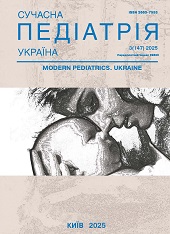Fetal anatomical variability of the stomach
DOI:
https://doi.org/10.15574/SP.2025.3(147).3540Keywords:
stomach, anatomical variability, topography, fetus, humanAbstract
The rapid development of fetal surgery and insufficient study of the variability of the shape, size, and topography of the stomach in fetuses determine the relevance of studying the anatomical features of this organ for improving the diagnosis and surgical correction of congenital defects.
Аim - to study the anatomical variability of the human fetal stomach at 4–10 months in order to accurately distinguish between normal and pathological development, improve prenatal diagnostics, and aid in planning neonatal surgical interventions.
Material and methods. The material for the study was preparations of 70 cadavers of human fetuses of both sexes with a parietal-coccygeal length of 81.0-375.0 mm, which was studied using macropreparation, radiography, morphometry, and statistical data processing methods.
Results. In the studied human fetuses, the stomach is completely located to the left of the median plane. The angle between the esophagus and the lesser curvature of the stomach is within 155-190°. In human fetuses, the stomach is completely located to the left of the median plane, mainly vertically at the level of the X thoracic - I-II lumbar vertebrae. At the end of the fetal period of human ontogenesis, a change in the skeletotropic level of the stomach occurs - its displacement in the caudal direction to the height of one vertebra. In late human fetuses, the folding of the gastric mucosa is well expressed.
Conclusions. In human fetuses, the following varieties of the stomach shape have been identified: flask-shaped (in the form of a retort) - 56% of cases, horn-shaped (20% of observations), funnel-shaped (14% of fetuses), sac-shaped (10%), rounded (8%) or slightly elongated (2%). During the second half of human intrauterine life, the stomach undergoes intensive development, the dimensions of which increase by 2.1-2.4 times.
The study was conducted in accordance with international and national bioethical standards, which was confirmed by the conclusion of the Biomedical Ethics Commission of the Bukovinian State Medical University.
The authors declare no conflict of interest.
References
Badiu CM, Lupu G, Stroică L, Marinescu T, Tarţa-Arsene E, Ispas AT. (2019)ю Morphometric study of fetal stomach dimensions. Romanian J Anat. 18: 7-13. URL: http://revanatomie.ro/en/abstract.php?an_rev=2019&nr_rev=1&nr_art=1.
Basta AM, Lusk LA, Keller RL, Filly RA. (2016). Fetal stomach position predicts neonatal outcomes in isolated left-sided congenital diaphragmatic hernia. Fetal Diagn Ther. 39(4): 248-255. https://doi.org/10.1159/000440649; PMid:26562540 PMCid:PMC4866917
Burdan F, Rozylo-Kalinowska I, Szumilo J, Zinkiewicz K, Dworzanski W, Krupski W et al. (2012). Anatomical classification of the shape and topography of the stomach. Surg Radiol Anat. 34(2): 171-178. https://doi.org/10.1007/s00276-011-0893-8; PMid:22057798 PMCid:PMC3284679
Cetin E, Malas MA, Albay S, Cankara N. (2006). The development of stomach during the fetal period. Surg Radiol Anat. 28(5): 438-446. https://doi.org/10.1007/s00276-006-0124-x; PMid:16906359
Furman MS, Connolly SA, Brown SD, Callahan MJ. (2021). The pediatric stomach - congenital abnormalities. Pediatr Radiol. 51(13): 2461-2469. https://doi.org/10.1007/s00247-021-05155-z; PMid:34351495
Karnul AM, Murthy CK. (2022). A study of variations of the stomach in adults and growth of the fetal stomach. Cureus. 4(8): e28517. https://doi.org/10.7759/cureus.28517; PMid:36185902 PMCid:PMC9515405
Lee E-G, Kim T-H, Huh Y-J, Suh Y-S, Ahn H-S, Kong S-H et al. (2016). Anthropometric study of the stomach. J Gastric Cancer. 16(4): 247. https://doi.org/10.5230/jgc.2016.16.4.247; PMid:28053811 PMCid:PMC5206315
McCormick BM, Blakemore KJ, Johnson CT, Bishop JC, Jelin EB, Miklos JM et al. (2021). Outcomes of both complex and isolated cases of infants with large stomach on fetal ultrasound. Am J Obstet Gynecol MFM. 3(1): 100272. https://doi.org/10.1016/j.ajogmf.2020.100272; PMid:33451621 PMCid:PMC8588797
Petrov RV, Su S, Bakhos CT, Abbas AE-S. (2019). Surgical anatomy of paraesophageal hernias. Thorac Surg Clin. 29(4): 359-368. https://doi.org/10.1016/j.thorsurg.2019.07.008; PMid:31564392 PMCid:PMC7263794
Sase M, Asada H, Okuda M, Kato H. (2002). Fetal gastric size in normal and abnormal pregnancies. Ultrasound Obstet Gynecol. 19(5): 467-470. https://doi.org/10.1046/j.1469-0705.2002.00695.x; PMid:11982979
Suzuki D, Kim JH, Shibata S, Murakami G, Rodríguez-Vázquez JF. (2019). Topographical anatomy of the greater omentum and transverse mesocolon: a study using human fetuses. Anat Cell Biol. 52(4): 443. https://doi.org/10.5115/acb.19.112; PMid:31949984 PMCid:PMC6952700
Teefey CP, Soni S, Khalek N. (2020). Maternal fetal surgery: Intervention and management. Clin Obstet Gynecol. 63(2): 455-467. https://doi.org/10.1097/GRF.0000000000000534; PMid:32265364
Winkler SM, Harrison MR, Messersmith PB. (2019). Biomaterials in fetal surgery. Biomater Sci. 7(8): 3092-3109. https://doi.org/10.1039/C9BM00177H; PMid:31099350 PMCid:PMC8232972
Yesupadam K, Devi K, Lakshmi V. (2016). A cadaveric study for structural variations of the stomach. Int J Res Med Sci. 4(8): 3473-3478. https://doi.org/10.18203/2320-6012.ijrms20162315
Downloads
Published
Issue
Section
License
Copyright (c) 2025 Modern pediatrics. Ukraine

This work is licensed under a Creative Commons Attribution-NonCommercial 4.0 International License.
The policy of the Journal “MODERN PEDIATRICS. UKRAINE” is compatible with the vast majority of funders' of open access and self-archiving policies. The journal provides immediate open access route being convinced that everyone – not only scientists - can benefit from research results, and publishes articles exclusively under open access distribution, with a Creative Commons Attribution-Noncommercial 4.0 international license (СС BY-NC).
Authors transfer the copyright to the Journal “MODERN PEDIATRICS. UKRAINE” when the manuscript is accepted for publication. Authors declare that this manuscript has not been published nor is under simultaneous consideration for publication elsewhere. After publication, the articles become freely available on-line to the public.
Readers have the right to use, distribute, and reproduce articles in any medium, provided the articles and the journal are properly cited.
The use of published materials for commercial purposes is strongly prohibited.

